python3 networkx
一.networkx
1.用于图论和复杂网络
2.官网:http://networkx.github.io/
3.networkx常常结合numpy等数据处理相关的库一起使用,通过matplot来可视化图
二.绘制图
1.创建图
import networkx as nx
import matplotlib.pyplot as plt G=nx.Graph()#创建空图,无向图
# G1=nx.DiGraph(e)#创建空图,有向图
# G = nx.Graph(name='my graph')#指定图的属性(name) 的值(my graph)
G.add_edges_from(([1,2],[2,3],[3,1])) e = [(1, 2), (2, 3), (3, 4)] # 边的列表
G2 = nx.Graph(e)#根据e来创建图 F=G.to_directed()#把无向图转换为有向图 #创建多图,类MultiGraph和类MultiDiGraph允许添加相同的边两次,这两条边可能附带不同的权值
# H=nx.MultiGraph(e)
H=nx.MultiDiGraph(e) plt.subplot(2,2,1)
nx.draw(G,with_labels=True)
plt.subplot(2,2,2)
nx.draw(G2,with_labels=True)
plt.subplot(2,2,3)
nx.draw(F,with_labels=True)
plt.subplot(2,2,4)
nx.draw(H,with_labels=True) plt.show()
创建图
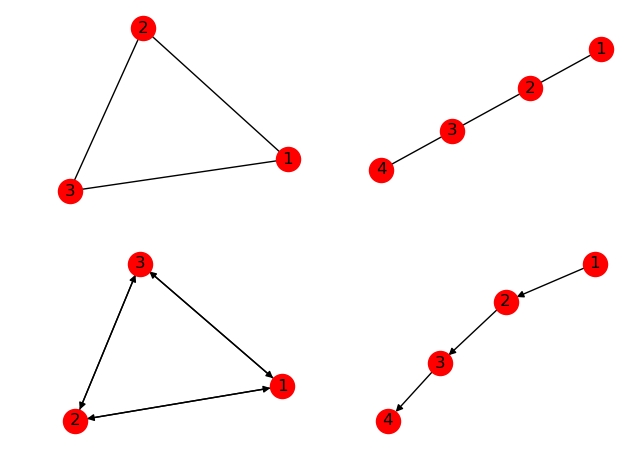

2.无向图
import networkx as nx
import matplotlib.pyplot as plt G=nx.Graph()#创建空图 #添加节点
G.add_node('a')
G.add_node(1) #添加单个节点
G.add_nodes_from([2,3,4]) #添加一些节点,容器,(可以是list, dict, set,) #添加边,如果点不在图中,会自动创建点
G.add_edge(1,'a',weight=1.2) #添加单条边,连接1,‘a’的边,可以赋予边属性以及他的值
G.add_edges_from([(2,3),(3,4)])#添加一些边(列表)
G.add_weighted_edges_from([(1,'a',0.1),(4,2,0.5)])#给边赋予权重 #移除边
G.remove_edge(2,4) #移除一条边
G.remove_edges_from([(3,4),]) #移除一些边 #移除节点,同时移除他对应的边
G.remove_node(1) #移除单个节点
G.remove_nodes_from([4,]) #移除一些节点 #绘图
nx.draw(G, # 图
pos=nx.circular_layout(G), # 图的布局
alpha=0.5, # 图的透明度(默认1.0不透明,0完全透明) with_labels=True, # 节点是否带标签
font_size=18, # 节点标签字体大小
node_size=400, # 指定节点的尺寸大小
node_color='blue', # 指定节点的颜色
node_shape='o', # 节点的形状 edge_color='r', # 边的颜色
width=0.8, # 边的宽度
style='solid', # 边的样式 ax=None, # Matplotlib Axes对象,可选在指定的Matplotlib轴中绘制图形。
) plt.show()
无向图
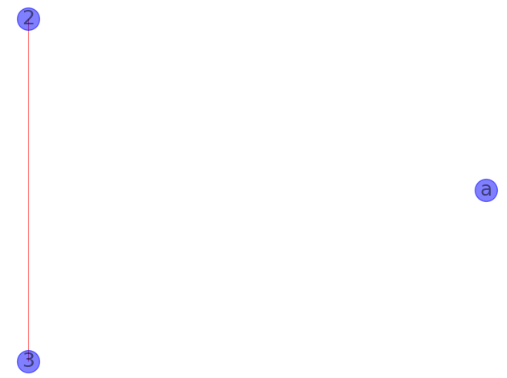
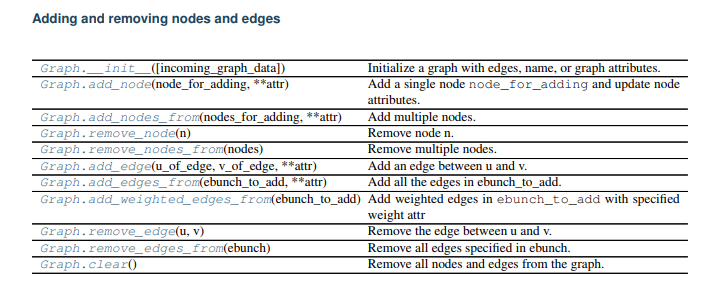
绘图布局

3.有向图和无向图的最大差别在于:有向图中的边是有顺序的,前一个表示开始节点,后一个表示结束节点。
三.图
数据结构



1.图的属性
#像color,label,weight或者其他Python对象的属性都可以被设置为graph,node,edge的属性
# 每个graph,node,edge都能够包含key/value这样的字典数据
import networkx as nx
import matplotlib.pyplot as plt G=nx.DiGraph([(1,2),(2,3),(3,4),(1,4),(4,2)],name='my digraph',a='b')
#创建一个有向图,赋予边,点,权重,以及有向图的属性name的值my digraph #属性都可以在定义时赋予,或者通过直接赋值来添加修改
#图属性
print(G)#图的名称
print(G.graph)#图的属性,字典
G.graph['b']=19#赋予属性
print(G.graph)
print('#'*60) #节点属性
print('图的节点:',G.nodes)#列表
print('节点个数:',G.number_of_nodes())
G.add_node('b',time='0.2')
print(G.node['b'])#显示单个节点的信息
G.node['b']['time']=0.3#修改属性
print(G.node['b'])
print('#'*60) #边属性
print('图的边:',G.edges)#列表
print ('边的个数:',G.number_of_edges())
G.add_edge('a','b',weight=0.6)
G.add_edges_from( [ (2,3),(3,4) ], color="red")
G.add_edges_from( [(1,2,{"color":"blue"}),(4,5,{"weight":8})])
G[1][2]["width"]=4.7#添加或修改属性
print(G.get_edge_data(1, 2))#获取某条边的属性
print('#'*60) nx.draw(G,pos = nx.circular_layout(G),with_labels=True) plt.show
--------------------------------------------------------------------------
my digraph
{'name': 'my digraph', 'a': 'b'}
{'name': 'my digraph', 'a': 'b', 'b': 19}
############################################################
图的节点: [1, 2, 3, 4]
节点个数: 4
{'time': '0.2'}
{'time': 0.3}
{2: {}, 4: {}}
############################################################
图的边: [(1, 2), (1, 4), (2, 3), (3, 4), (4, 2)]
边的个数: 5
{'color': 'blue', 'width': 4.7}
属性

2.边和节点
import networkx as nx
import matplotlib.pyplot as plt G=nx.DiGraph([(1,2,{'weight':10}),(2,3),(3,4),(1,4),(4,2)]) nx.add_path(G, [0, 4,3])#在图中添加路径 # 对1节点进行分析
print(G.node[1])#节点1的信息
G.node[1]['time']=1#赋予节点属性
print(G.node[1])
print(G[1]) # 1相关的节点的信息,他的邻居和对应的边的属性
print(G.degree(1)) # 1节点的度
print('#'*60) # 对【1】【2】边进行分析
print(G[1][2]) # 查看某条边的属性
G[1][2]['weight'] = 0.4 # 重新设置边的权重
print(G[1][2]['weight']) # 查看边的权重
G[1][2]['color'] = 'blue' # 添加属性
print(G[1][2]) nx.draw(G,pos = nx.circular_layout(G),with_labels=True) plt.show()
------------------------------------------------------------------
{}
{'time': 1}
{2: {'weight': 10}, 4: {}}
2
############################################################
{'weight': 10}
0.4
{'weight': 0.4, 'color': 'blue'}
边和节点
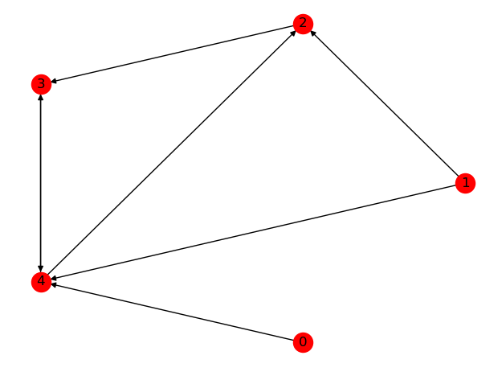
3.有向图
import networkx as nx
import matplotlib.pyplot as plt G=nx.DiGraph([(1,2,{'weight':10}),(2,3),(3,4),(1,4),(4,2)])
print('#'*60)
print(G.edges)#An OutEdgeView of the DiGraph as G.edges or G.edges().
print(G.out_edges)#An OutEdgeView of the DiGraph as G.edges or G.edges().
print(G.in_edges)#An InEdgeView of the Graph as G.in_edges or G.in_edges()
print('#'*60) print(G.degree)#图的度
print(G.out_degree)#图的出度
print(G.in_degree)#图的入度
print('#'*60) print(G.adj)#Graph adjacency object holding the neighbors of each node
print(G.neighbors(2))#节点2的邻居
print(G.succ)#Graph adjacency object holding the successors of each node
print(G.successors(2))#节点2的后继节点
print(G.pred)#Graph adjacency object holding the predecessors of each node
print(G.predecessors(2))#节点2的前继节点
#以列表形式打印
print([n for n in G.neighbors(2)])
print([n for n in G.successors(2)])
print([n for n in G.predecessors(2)]) nx.draw(G,pos = nx.circular_layout(G),with_labels=True) plt.show()
--------------------------------------------------------
############################################################
[(1, 2), (1, 4), (2, 3), (3, 4), (4, 2)]
[(1, 2), (1, 4), (2, 3), (3, 4), (4, 2)]
[(1, 2), (4, 2), (2, 3), (3, 4), (1, 4)]
############################################################
[(1, 2), (2, 3), (3, 2), (4, 3)]
[(1, 2), (2, 1), (3, 1), (4, 1)]
[(1, 0), (2, 2), (3, 1), (4, 2)]
############################################################
{1: {2: {'weight': 10}, 4: {}}, 2: {3: {}}, 3: {4: {}}, 4: {2: {}}}
<dict_keyiterator object at 0x0DA2BF00>
{1: {2: {'weight': 10}, 4: {}}, 2: {3: {}}, 3: {4: {}}, 4: {2: {}}}
<dict_keyiterator object at 0x0DA2BF00>
{1: {}, 2: {1: {'weight': 10}, 4: {}}, 3: {2: {}}, 4: {3: {}, 1: {}}}
<dict_keyiterator object at 0x0DA2BF00>
[3]
[3]
[1, 4]
有向图

4.图的操作
Applying classic graph operations

import networkx as nx
import matplotlib.pyplot as plt G=nx.DiGraph([(1,2,{'weight':10}),(2,1,{'weight':1}),(2,3),(3,4),(1,4),(4,2)])
G2=nx.DiGraph([(1,'a'),('a','b'),(1,4)]) H=G.subgraph([1,2,4])#产生关于节点的子图 G3=nx.compose(H,G2)#结合两个图并表示两者共同的节点 plt.subplot(221)
nx.draw(G,pos = nx.circular_layout(G),with_labels=True,name='G') plt.subplot(222)
nx.draw(H,pos = nx.circular_layout(G),with_labels=True) plt.subplot(223)
nx.draw(G2,with_labels=True) plt.subplot(224)
nx.draw(G3,with_labels=True) plt.show()
生成图
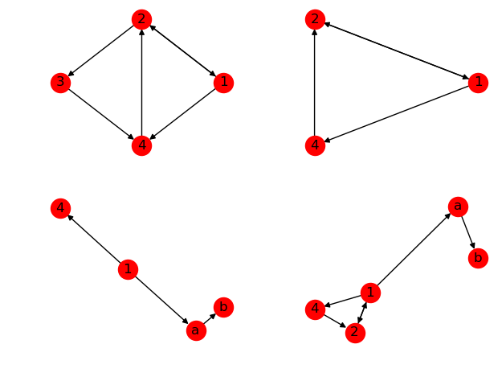
4.算法
...
四.简单根据数据画图
import networkx as nx
import matplotlib.pyplot as plt #1.导入数据:
# networkx支持的直接处理的数据文件格式adjlist/edgelist/gexf/gml/pickle/graphml/json/lead/yaml/graph6/sparse6/pajek/shp/
#根据实际情况,把文件变为gml文件
G1 = nx.DiGraph()
with open('file.txt') as f:
for line in f:
cell = line.strip().split(',')
G1.add_weighted_edges_from([(cell[0],cell[1],cell[2])])
nx.write_gml(G1,'file.gml')#写网络G进GML文件 G=nx.read_gml("file.gml") #读取gml文件
# parse_gml(lines[,relael]) 从字符串中解析GML图
# generate_gml(G) 以gml格式生成一个简单条目的网络G print(G.nodes)
print(G.edges) #2.在figure上先设置坐标
plt.title("图G")
plt.ylabel("y")
plt.xlabel("x")
plt.xlim(-1,1)
plt.ylim(-1,1) #再在坐标轴里面调节图形大小
#整个figure按照X与Y轴横竖来平均切分,以0到1之间的数值来表示
#axes([x,y,xs,ys]),如果不设置
#其中x代表在X轴的位置,y代表在Y轴的位置,xs代表在X轴上向右延展的范围大小,yx代表在Y轴中向上延展的范围大小
plt.axes([0.1, 0.1, 0.8, 0.8]) #3.在axes中绘图
nx.draw(G,pos = nx.circular_layout(G),with_labels=True,) #4.保存图形
plt.savefig("file.png")#将图像保存到一个文件 plt.show()
-----------------------------------------------------
['', '', '', '', '', '', '', '', '', '', '', '', '', '', '', '', '', '', '', '', '', '', '', '', '', '', '', '', '', '', '', '', '', '', '', '', '', '', '', '', '', '', '', '', '', '', '', '', '', '', '', '', '', '', '', '', '', '', '', '', '', '', '', '', '', '', '', '', '', '', '', '', '', '', '', '', '', '', '', '', '', '', '', '', '', '', '', '', '', '', '', '', '', '']
[('', ''), ('', ''), ('', ''), ('', ''), ('', ''), ('', ''), ('', ''), ('', ''), ('', ''), ('', ''), ('', ''), ('', ''), ('', ''), ('', ''), ('', ''), ('', ''), ('', ''), ('', ''), ('', ''), ('', ''), ('', ''), ('', ''), ('', ''), ('', ''), ('', ''), ('', ''), ('', ''), ('', ''), ('', ''), ('', ''), ('', ''), ('', ''), ('', ''), ('', ''), ('', ''), ('', ''), ('', ''), ('', ''), ('', ''), ('', ''), ('', ''), ('', ''), ('', ''), ('', ''), ('', ''), ('', ''), ('', ''), ('', ''), ('', ''), ('', ''), ('', ''), ('', ''), ('', ''), ('', ''), ('', ''), ('', ''), ('', ''), ('', ''), ('', ''), ('', ''), ('', ''), ('', ''), ('', ''), ('', ''), ('', ''), ('', ''), ('', ''), ('', ''), ('', ''), ('', ''), ('', ''), ('', ''), ('', ''), ('', ''), ('', ''), ('', ''), ('', ''), ('', ''), ('', ''), ('', ''), ('', ''), ('', ''), ('', ''), ('', ''), ('', ''), ('', ''), ('', ''), ('', ''), ('', ''), ('', ''), ('', ''), ('', ''), ('', ''), ('', ''), ('', ''), ('', ''), ('', ''), ('', ''), ('', ''), ('', ''), ('', ''), ('', ''), ('', ''), ('', ''), ('', ''), ('', ''), ('', ''), ('', ''), ('', ''), ('', ''), ('', ''), ('', ''), ('', ''), ('', ''), ('', ''), ('', ''), ('', ''), ('', ''), ('', ''), ('', ''), ('', ''), ('', ''), ('', ''), ('', ''), ('', ''), ('', ''), ('', ''), ('', ''), ('', ''), ('', ''), ('', ''), ('', ''), ('', ''), ('', ''), ('', ''), ('', ''), ('', ''), ('', ''), ('', ''), ('', ''), ('', ''), ('', ''), ('', ''), ('', ''), ('', ''), ('', ''), ('', ''), ('', ''), ('', ''), ('', ''), ('', ''), ('', ''), ('', ''), ('', ''), ('', ''), ('', ''), ('', ''), ('', ''), ('', ''), ('', ''), ('', ''), ('', ''), ('', ''), ('', ''), ('', ''), ('', ''), ('', ''), ('', ''), ('', ''), ('', ''), ('', ''), ('', ''), ('', ''), ('', ''), ('', ''), ('', ''), ('', ''), ('', ''), ('', ''), ('', ''), ('', ''), ('', ''), ('', ''), ('', ''), ('', ''), ('', ''), ('', ''), ('', ''), ('', ''), ('', ''), ('', ''), ('', ''), ('', ''), ('', ''), ('', ''), ('', ''), ('', ''), ('', ''), ('', ''), ('', ''), ('', ''), ('', ''), ('', ''), ('', ''), ('', ''), ('', ''), ('', ''), ('', ''), ('', ''), ('', ''), ('', ''), ('', ''), ('', ''), ('', ''), ('', ''), ('', ''), ('', ''), ('', ''), ('', ''), ('', ''), ('', ''), ('', ''), ('', ''), ('', ''), ('', ''), ('', ''), ('', ''), ('', ''), ('', ''), ('', ''), ('', ''), ('', ''), ('', ''), ('', ''), ('', ''), ('', ''), ('', ''), ('', ''), ('', ''), ('', ''), ('', ''), ('', ''), ('', ''), ('', ''), ('', ''), ('', ''), ('', ''), ('', ''), ('', ''), ('', ''), ('', ''), ('', ''), ('', ''), ('', ''), ('', ''), ('', ''), ('', ''), ('', ''), ('', ''), ('', ''), ('', ''), ('', ''), ('', ''), ('', ''), ('', ''), ('', ''), ('', ''), ('', ''), ('', ''), ('', ''), ('', ''), ('', ''), ('', ''), ('', ''), ('', ''), ('', ''), ('', ''), ('', ''), ('', ''), ('', ''), ('', ''), ('', ''), ('', ''), ('', ''), ('', ''), ('', ''), ('', ''), ('', ''), ('', ''), ('', ''), ('', ''), ('', ''), ('', ''), ('', ''), ('', ''), ('', ''), ('', ''), ('', ''), ('', ''), ('', ''), ('', '')]
绘图
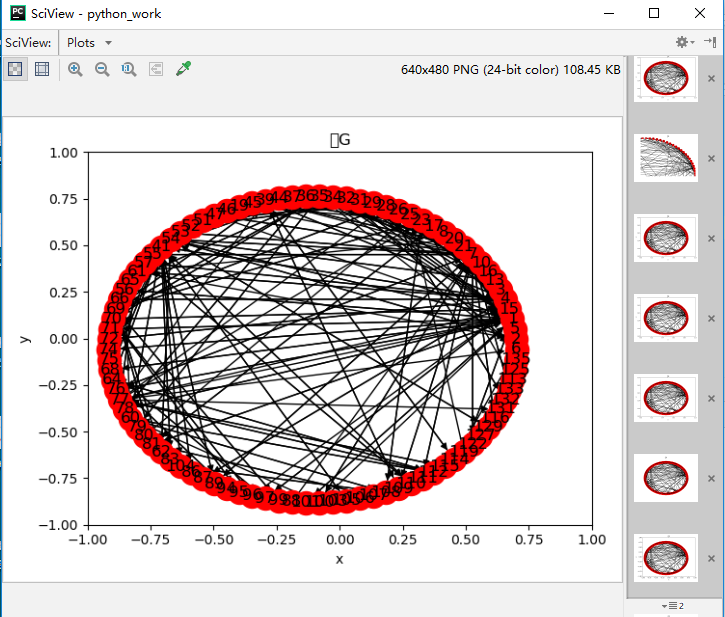
5.分析图
import networkx as nx
import matplotlib.pyplot as plt G=nx.read_gml("file.gml")
UG=G.to_undirected() #网络信息
print(nx.info(G))
eccen = nx.eccentricity(UG)#节点离心度
print(eccen)
print(max(eccen.values()))
print(min(eccen.values()))
# print(nx.diameter(G)) # 网络直径
# print(nx.radius(G)) #网络半径
print(nx.average_shortest_path_length(G)) # 网络平均最短距离
print(nx.average_shortest_path_length(UG)) # 网络平均最短距离 #度分布
degree=nx.degree_histogram(G)#所有节点的度分布序列
print(degree)
x=range(len(degree)) #生成x轴序列
y=[z/float(sum(degree))for z in degree]#将频次转换为频率
plt.loglog(x,y,color='blue',linewidth=2)#在双对数坐标轴上绘制分布曲线 #度中心度
print(nx.degree_centrality(G))#计算每个点的度中心性
print(nx.in_degree_centrality(G))#计算每个点的入度中心性
print(nx.out_degree_centrality(G))#计算每个点的出度中心性 #紧密中心度
print(nx.closeness_centrality(G)) #介数中心度
print(nx.betweenness_centrality(G)) #特征向量中心度
print(nx.eigenvector_centrality(G)) #网络密度
print(nx.density(G)) #网络传递性
print(nx.transitivity(G)) #网络群聚系数
print(nx.average_clustering(UG))
print(nx.clustering(UG)) #节点度的匹配性
print(nx.degree_assortativity_coefficient(UG)) plt.show()
------------------------------------------------------------------
分析图
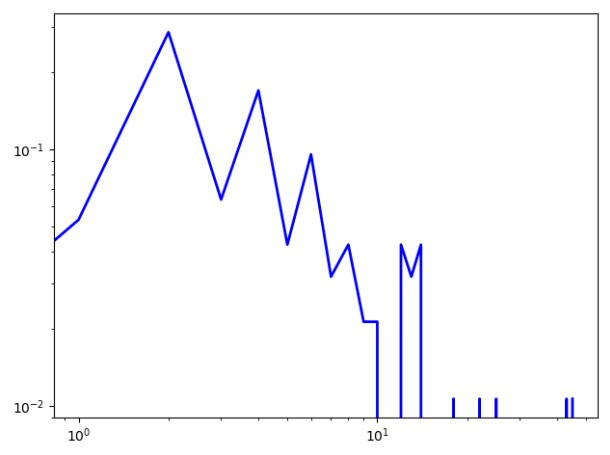
五.补充
1.更精细地画图,可以绘制特定的边和点,一般默认全画
import networkx as nx
import matplotlib.pyplot as plt #1.获得带权图
G = nx.Graph()
G.add_edges_from([('a', 'b', {'weight':0.6}),
('a', 'c', {'weight':0.2}),
('a', 'd', {'weight':0.1}),
('c', 'e', {'weight':0.7}) ]) #2.对不同权重进行处理,取得相应权重的点集列表,比如weight>0.5的点集列表为[('a', 'b'), ('c', 'e')]
elarge = [(u, v) for (u, v, d) in G.edges(data=True) if d['weight'] > 0.5]
esmall = [(u, v) for (u, v, d) in G.edges(data=True) if d['weight'] <= 0.5]
node1=['a','b']
node2=['c','d','e']
node3={ u:v for (u, v, d) in G.edges(data=True) if d['weight'] > 0.5}
edge={(u,v):d['weight'] for (u, v, d) in G.edges(data=True) if d['weight'] > 0.5} #3.必须设定一个统一的布局,保证下面分步绘制的图的统一性,而且分步绘制时pos是一个必须参数
pos = nx.spring_layout(G) #4.分步绘制完整的图
#(1)绘制点,必须参数(G,pos),还可以指定点集(列表或optional)(默认全点集),形状,大小,透明度,等
nx.draw_networkx_nodes(G,pos=pos,nodelist=node1)
nx.draw_networkx_nodes(G,pos=pos,nodelist=node2,node_shape='*',node_color='r',node_size=700) #(2)绘制边,必须参数(G,pos),还可以指定边集(边的元组集合(列表))(默认全边集),形状,大小,透明度,等
nx.draw_networkx_edges(G, pos=pos, edgelist=elarge)
nx.draw_networkx_edges(G, pos=pos, edgelist=esmall,edge_color='b',style='dashed', width=3) #(3)绘制部分节点的标签,必须参数(G,pos),还可以指定点集(字典(值)或optional)(默认全点集),形状,大小,透明度,等
#给node3字典中的值‘b’和‘e’添加标签
nx.draw_networkx_labels(G,pos=pos, labels=node3,font_size=18,font_color='b',font_family='sans-serif') #(4)绘制边的标签,必须参数(G,pos),还可以指定边集(字典:键是边的元组,值是边的某个属性值)(默认全边集),形状,大小,透明度,等
#根据字典,通过键给边添加值的标签,{('a', 'b'): 0.6, ('c', 'e'): 0.7}
nx.draw_networkx_edge_labels(G,pos=pos,edge_labels=edge,font_size=7,font_color='black',font_family='sans-serif') #5.显示
plt.axis('off')
plt.show()
精细地作图
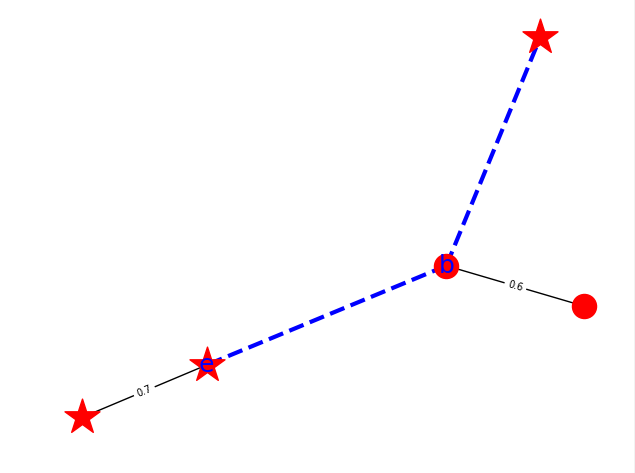
python3 networkx的更多相关文章
- Python3画图系列——NetworkX初探
NetworkX 概述 NetworkX 主要用于创造.操作复杂网络,以及学习复杂网络的结构.动力学及其功能.用于分析网络结构,建立网络模型,设计新的网络算法,绘制网络等等.安装networkx看以参 ...
- python3.5安装Numpy、mayploylib、opencv等额外库
安装Python很简单,但是安装额外的扩展库就好麻烦,没有了第三方库的Python就是一个鸡肋~~ 我们现在安装NumPy库 1. 首先这里假设你已经安装了Python了,不会的去看我的另一篇博文( ...
- windows7下搭建python环境并用pip安装networkx
1.安装顺序:Python+pip+pywin32+numpy+matplotlib+networkx 2.版本问题 所安装的所有程序和包都需要具有统一的python版本.系统版本和位宽,所以第一步要 ...
- Python3入门(一)——概述与环境安装
一.概述 1.python是什么 Python 是一个高层次的结合了解释性.编译性.互动性和面向对象的脚本语言. Python 是一种解释型语言: 这意味着开发过程中没有了编译这个环节.类似于PHP和 ...
- Python3.x:第三方库简介
Python3.x:第三方库简介 环境管理 管理 Python 版本和环境的工具 p – 非常简单的交互式 python 版本管理工具. pyenv – 简单的 Python 版本管理工具. Vex ...
- 使用networkx库可视化对称矩阵的网络图形
首先我的数据是.mat格式,讲讲如何用python读取.mat格式的数据(全套来) 我是python3版本 第一种读取方法: import h5py features_struct = h5py.Fi ...
- python3 threading初体验
python3中thread模块已被废弃,不能在使用thread模块,为了兼容性,python3将thread命名为_thread.python3中我们可以使用threading进行代替. threa ...
- Python3中的字符串函数学习总结
这篇文章主要介绍了Python3中的字符串函数学习总结,本文讲解了格式化类方法.查找 & 替换类方法.拆分 & 组合类方法等内容,需要的朋友可以参考下. Sequence Types ...
- Mac-OSX的Python3.5虚拟环境下安装Opencv
Mac-OSX的Python3.5虚拟环境下安装Opencv 1 关键词 关键词:Mac,OSX,Python3.5,Virtualenv,Opencv 2 概述 本文是一篇 环境搭建 的基础 ...
随机推荐
- svn在cleanup 时,提示privious operation has not finished,解决方案
在updated代码时,svn 提示 上一次操作失败,需要cleanup. 执行cleanup时,提示:cleanup失败,因为上一次操作失败,请先执行cleanup.很幽默的提示. svn的“.sv ...
- 机器学习实战-logistic回归分类
基于LR的回归分类实例 概念 前提理解: 机器学习的三个步骤:模型,损失函数(即样本误差),优化求解(通过损失函数,使得模型的样本误差最小或小于阈值,求出满足条件的参数,优化求解包括:最小二乘法,梯度 ...
- element-ui 开发备忘
目录 购物清单的数据结构说明 1. <el-radio> 的 label 属性 2. 在 <el-table> 中放入表单组件 3. 表单验证时填写正确的 prop 属性 总结 ...
- losetup命令使用
1.losetup命令 Linux系统losetup命令用来设置循坏设备,循坏设备可以把文件虚拟成块设备,借此来模拟整个文件系统,让用户得以将其视为硬盘驱动器,光驱等设备,并挂入当作目录来使用. (1 ...
- MySQL 索引小结
1.!=.not in 在primary key上使用 !=.not in,explain 的 type 是 range,非primary key是全表扫描(即非主键字段即使有索引也无法应用) 2.a ...
- java -jar参数运行方式设置classpath
转载自:https://www.cnblogs.com/aggavara/archive/2012/11/16/2773246.html 当用java -jar yourJarExe.jar来运行一个 ...
- python修改linux日志(logtamper.py)
原作者原文:https://blog.csdn.net/qq_27446553/article/details/51434451 躲避管理员who查看 python logtamper.py -m - ...
- 通过静态发现方式部署 Etcd 集群
在「etcd使用入门」一文中对etcd的基本知识点和安装做了一个简要的介绍,这次我们来说说如何部署一个etcd集群. etcd构建自身高可用集群主要有三种形式: 静态发现: 预先已知etcd集群中有哪 ...
- Asp.Net Core Web Api 使用 Swagger 生成 api 说明文档
最近使用 Asp.Net Core Web Api 开发项目服务端.Swagger 是最受欢迎的 REST APIs 文档生成工具之一,进入我的视野.以下为学习应用情况的整理. 一.Swagger 介 ...
- C#条码生成及打印实例代码
";//条码 ; ; //打印按钮 private void button1_Click(object sender, EventArgs e) { //实例化打印对象 PrintDocum ...
